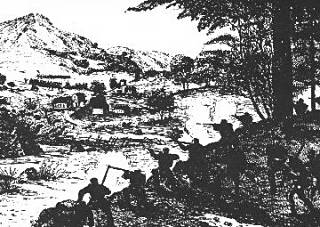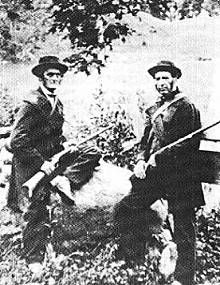In 1866, the Fenians launched a series of raids on Canadian territory. One was at Pigeon Hill, on the Quebec-Vermont border. Led by a man named "General" Samuel Spear, several hundred Fenians marched six miles into Canada, where they planted a bright green flag. A small Canadian force saw them coming, but wisely retreated. The Fenians met no soldiers, so they busied themselves by stealing chickens, pigs, or liquor from farms in the area. A veritable armed mob, they plundered nearby St. Armand and Frelighsburg (Slab City), and, it was said, "insulted and abused" the local population. On hearing that Canadian reinforcements were approaching, the Fenians began a disorganized retreat to the U.S. The last 200 stragglers were charged by a volunteer cavalry troop who managed to capture sixteen prisoners. Once back on American soil, the Fenians had their guns confiscated by American soldiers.
The Battle of Eccles Hill- May 25th 1870.
Two members of the Home Guard, 1870. (Source: Missisquoi Museum)
They are seen with their Ballard rifles.
Another raid occurred in 1870 at Eccles Hill (not far from Pigeon Hill), when 400 Fenians under the command of "General" John O'Neill, President of the Fenian Brotherhood, were repulsed by a much smaller group of Canadian home-guard and militiamen who were waiting there to meet them. Two Fenians were killed and nine were injured. No Canadians were hurt or killed. O'Neill's words to his troops were these: "Men of Ireland, I am ashamed of you."
A little more background regarding these events----sorry if some it repeats what has already been mentioned above.
Steps were quickly taken to acquire newer breechloading weapons. The Canadian government purchased 3,000 Peabody rifles, with bayonets, from the Providence Tool Company of Providence, R.I. Starr carbines and Spencer repeating rifles were also acquired in the United States.
The farmers of the St. Armand area, concerned about their lack of defense during the Fenian raid of 1866, sent two representatives south to Massachusetts, where they bought 40 Ballard sporting rifles. It is curious to note that the U.S. government took no steps to impede those arm sales to a foreign government with whom relations were strained.
Perhaps believing that a military victory would unite the organization, or perhaps choosing to act before his power base totally collapsed, O’Neill prepared for another invasion of Canada in the spring of 1870. He established a base of operations at Franklin, Vt., where he positioned his war stocks of 15,000 weapons and 3 million rounds of small-arms ammunition. O’Neill had also been able to acquire at least one field artillery piece.
The time came for his volunteers to assemble, but no more than 400 men arrived to arm themselves for the next great Fenian expedition. A far smaller group was assembling near Malone, N.Y., to conduct a simultaneous attack. When General O’Neill and his small army set off for the Canadian border on the morning of May 25, 1870, they must have been greatly disappointed that so few of their comrades had turned out for the invasion.
Lieutenant Colonel William Osborne Smith, a Canadian career army officer, was the commander of the military district that lay in the path of the Fenian advance. Osborne Smith had received intelligence reports of Fenian activity as early as May 22 and had issued orders for the militia to mobilize. While units from the Montreal area marched south, local militia organizations occupied defensive positions on the border.
The farmers who had suffered property losses during the Fenian raids of 1866 had banded together to form the Missiquoi Home Guard. With Ballard sporting rifles firmly in hand, 37 members of the guard occupied the strategic heights of Eccles Hill, which gave them a commanding view of the border to the south. Lieutenant Colonel Brown Chamberlin soon reinforced the home guards with members of the 60th Missiquoi Battalion.
Osborne Smith, who was hurrying to the border with the 3rd Victoria Rifles and the Montreal Troop of Cavalry, raced ahead to Eccles Hill. He conferred with Chamberlin about the defense plan and then galloped away to bring up additional units. After traveling a few miles, Osborne Smith was halted by a messenger from the south who informed him that the Fenian attack had commenced. Turning around, Osborne Smith drove his lathered mount back to Eccles Hill, where he personally assumed command.
The Fenian advance guard crossed the border around noon. As the Irishmen marched in close ranks, they came under a withering hail of fire from the concealed positions of the home guards. Surprised by the Canadian troops’ determined defense, the Fenians scattered, either taking cover or retreating across the border.
Just after 1 p.m., U.S. marshals located O’Neill near the Vermont border and arrested him. O’Neill, who probably realized that his offensive was doomed to failure, made no effort to evade the lawmen.
One of the Fenian leaders who fell during the attack was Captain E. Croman, a Civil War veteran who had somehow managed to receive a first-class certificate from the Montreal Military School for militia officers. He died of his wounds a few days after the battle.
For several hours the militia and the Fenians exchanged fire. At about 2 p.m., the Montreal Cavalry and the Victoria Rifles arrived to bolster the Canadian defenses. Likewise, the Fenian force was strengthened by 100 men of the 4th New York Fenian Regiment.
At 5:45 p.m., Osborne Smith was informed that the Fenians were bringing up field artillery to bombard the Canadian position. He determined that it was time to seize the initiative. Positioning the Victoria Rifles on high ground to cover the attack, he ordered the home guards and the 60th Missiquoi Battalion to advance. The Canadian charge was too much for the Irish Americans, who sprinted across the border, leaving much of their equipment behind. Two Fenians were killed and several more were wounded. The victorious Canadians were completely unscathed.
A halfhearted Fenian attack near Holbrook Corners, Quebec, was easily repulsed two days later by a massed force of 1,000 Canadian militia and BritishRegulars.
The Fenian drama was over.
- Knowledge Library

- MKL Entry of the Month
- Australia
- Austro-Hungarian Empire
- Canada
- Czechoslovakia
- Denmark
- Finland
- France/Belgium
- Germany
- Italy
- Japan
- Norway
- Russia
- South America
- Sweden
- Switzerland
- Turkey
- United Kingdom
- United States
- Yugoslavia
- Is my rifle authentic or a fake?
- Jay Currah's Lee Enfield Web Site
- On-line Service Records (Canada)
- Technical Articles/Research
- Forum
- Classifieds

- What's New?
-
Photo Gallery

- Photo Gallery Options
- Photo Gallery Home
- Search Photo Gallery List
-
Photo Gallery Search
- Video Club

- iTrader













 PM
PM
